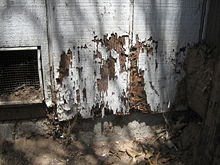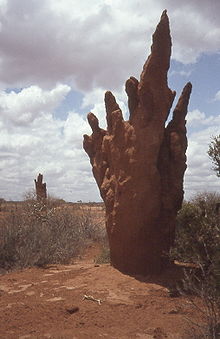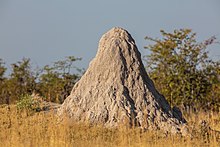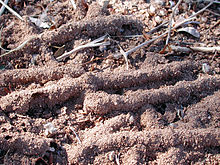Isoptera
The isoptera (Isoptera, from the Greek ισός isós, 'equal', and πτερον pteron, ' wing'; 'equal wings') are an infraorder of neopterous insects, known as termites, termes, turiros, comejenes, moths and also as white ants, due to their superficial resemblance to ants, with which they are not evolutionarily related, since the latter are hymenoptera. They are closely related to cockroaches, as both groups shared ancestors that inhabited Earth during the Carboniferous and Permian periods and are now classified in the same order.
Until recently, termites were classified in the order Isoptera, but were later accepted as an infraorder of the order Blattodea and in the suborder Blattoidea along with their closest relatives the genus Cryptocercus and the family Blattidae. They have even been further degraded, to the superfamily Termitoidea, according to some authors.
Its scientific name refers to the fact that adult termites have two pairs of wings of equal size. They are a group of social insects that build nests (termite mounds). Termites feed on the cellulose contained in wood and its derivatives, which they degrade thanks to the action of the protozoa of their digestive system, with which they live in symbiosis. Most termites are from tropical or subtropical climates, but a few live in temperate climates. Some 3,000 species are known, six of which have been introduced to other regions as urban pests.
General information
Termites are abundant and diverse in South America, Africa, and Australia, particularly in lowland tropical forests and savannahs. Many species build colonies in the form of mounds and many others are arboreal or subterranean. Mound-building termites remove large amounts of soil from hard, infertile soils, contributing to the growth of small plants that can reach the size of shrubs and small trees.
Termites by themselves are not capable of digesting cellulose, but they can take advantage of its nutrients thanks to the degradation of cellulose carried out by protozoa that live in symbiosis within the digestive system of the workers. The feeding of the termite mound is produced by trophalaxis, the termites transport the food in the digestive system, and transmit it to other individuals through the anal canal or the mouth. Termites are economically important as pests on wooden structures, artwork, and stored products.
It is difficult to know if a structure is being attacked by a colony of termites due to its small size and because they have negative phototropism, that is, they flee from light. Currently, there are specialized devices to listen to them through a partition and find out if there really is termitic activity.
The entire volume of a wooden beam contains cellulose, so the entire beam can be eaten by termites. They begin to consume it through the areas that are included in the work, advancing through the entire piece; being able to present a normal external appearance that is pierced inside. The termite eats wood with chitinized jaws; ingest the particles and carry out a second crushing at the level of the crop. Immediately, the wood passes to the middle intestine, where it undergoes the action of proteolytic and amylolytic enzymes; from here it goes to the fermentation chamber, where it is ingested by the protozoa, responsible for the digestion of cellulose.
Termites go through anything to get to wood, even concrete if necessary. To carry out this action, many times they take advantage of the concrete joints to cross supposedly impassable walls, but other times they shell the material making a gallery that crosses the wall without problems.
They live in colonies that can number up to three million individuals. In each colony, the queen or queens are the only ones that lay eggs and their ovaries increase in size surprisingly. Most of these insects are wingless, but during the breeding season some develop them and leave the group to form their own colonies. Termites consume cellulose in all forms. That is why these insects not only feed on wood in homes and buildings, but on everything in their path that contains it, they will consume paper, carpets and any other cellulose-based material.
Types of termites
Researchers identify three ecological groups of termites.
Dampwood Termites
They live in soft environments such as wood and humid soils, coming from environments near bodies of water. Coniferous forests are the most representative habitat for this type of termite.
Drywood Termites
They prefer dry, hard types of wood. They are found in natural environments and in urban areas where wood is handled for commercial purposes. These termites resist long periods without water and can become invasive.
Subterranean Termites
They are found under buildings and feed on wood available in the vicinity. It is common for them to appear in homes and buildings, destroying part of the buildings and becoming pests.
Biotic cycle
Isoptera are hemimetabolous insects with egg, nymph, and adult phases. Adults are differentiated into castes:
Termite Breeds
The castes of termites are the different types of termites, basically there are three: workers, soldiers and reproductive, although in some species there is a fourth caste: pseudoergous. Despite being different adult forms, all individuals share the same DNA, however, due to the effect of the hormones produced by the individuals of each caste, the larvae end up developing as adults with characteristics typical of one caste or another through somewhat unknown processes.. For example, more adults of a certain caste appear the smaller the number of adults of this caste compared to what there should be.
Laborers
They are apterous (wingless), of both sexes, and are sterile. They are usually blind with the exception of the family Hodotermitidae. This caste plays an important role in the colonies, since it is the one that carries out most of the work in the nest, among which we can mention: its construction and maintenance; the care and feeding of juveniles; feeding the castes that cannot feed themselves like the soldiers and the royal couple; development of tunnels for the search for food; grooming and cleaning of other castes, etc. Their body is generally slightly sclerotized.
Soldiers
They can be of both sexes, but their adults are sterile. They are easily recognized for having a large and well-sclerotized head, which sometimes becomes larger than the rest of the body. Many have highly developed jaws to bite the enemy; others are more specialized and have a pointed rostrum associated with glands, so that they can repel other animals with squirts of this secretion. The secretions can be of different types, although the most normal thing is that they are toxic, repellent or sticky. Its role is the defense of termite colonies.
- Mandibulated welding: it is the most emblematic type of welding termite; it is characterized by a particularly large and strong head with a mandible also especially large and strong; its method of combat is based on the struggle of body to body through mordiscs and/or cuts; its jaws can be asymmetrical to enhance its cutting capacity on one side. In addition, they can also issue mosquitoes by putting the jaws together to intimidate.
- Framotic soldiers: they use their heads wide and hard as a shield to cover tunnels and thermoter holes and prevent enemy incursions from moving forward without as many casualties or injuries as it could cause other methods of containment, but with the inconvenience that it has a lower offensive capacity and to cause casualties to the enemy.
- Nariguous soldiers: they have a particularly large head and very small jaws unusable for war; their method of struggle is to shoot substances to neutralize their enemies.
- Welded nasutoids: with a spatially large head, they combine the chemical attacks with a mandible more developed than the narigud soldiers who have different degrees of operativity for combat according to the type; it is, therefore, a kind of fusion between the mandible soldier and the narigudo soldier.
Their percentage varies between 2% and 10% depending on the sources (15% depending on some apparently unselected images).
Players
Winged
Winged are imagos that still have their wings. The winged spawners are the ones that can produce new queens and kings. The winged ones leave the colony en masse, when they meet, mating occurs in tunnels to evade predators and other hazards. They can easily be confused with winged ants. To differentiate between them one must look at details such as the antennae, abdomen, and length of their wings. The winged lose their wings immediately or following contact with the opposite sex.
Primary Reproducers (Royal Pair)
The primary spawners are called King and Queen. Their bodies are normally well sclerotized, except in the female of some species, whose abdomen can become enormous due to hypertrophied ovaries.
Secondary Players
In the event that the queen dies or that she is very old and her egg production decreases, substitute queens called neotenics (or replacement reproductives) can be produced, their function is to continue expanding the colony. Their bodies are normally less sclerotized than the primaries.
Pseudoergs
Casta not present in all termite mounds. Not totally differentiated individuals that, depending on the needs of the colony, can transform into one of the three main castes: workers, soldiers or secondary reproductives.
Location and pests
In 1930 the Reticulitermes flavipes was introduced into Central Europe, and since 1937 it has not stopped spreading, currently being found in various cities in France and Germany, such as Hamburg. There is also the danger of the spread of Zootermopis angusticollis, introduced for the first time in 1956, coming from the United States like the previous one. In southern Europe and North Africa are found the Isopterans Kalotermes flavicollis and Retuculilitermes lucifugus, which are the only two species native to Europe. In tropical Africa, the Termes bellicosus is found.
Use of Boric Acid
Since 1948, boric acid has been used to combat termite invasion.[citation needed]
Types of nests
Another feature of all eusocial insects are nests; in the case of termites they present a great diversity; sometimes they present a complex architecture, being able to reach formidable sizes (more than 1000 m³ in some Macrotermes ).
The termites' primitive habitat was probably inside dead wood, such as logs, dead parts of living trees; where society found food and shelter, what they call one-piece nests.
Within the group of separate nests, three main categories can be distinguished:
- Underground nests, this thermoter is in the subsoil, over 40 m (meters)[chuckles]required] the place where their signals are detected.
- Epige nests or thermos cathedrals, they are a type of nest that stands out from the surface of the ground (assembles). Some termites build nests as columns that can measure 8 m, but the most common thing is that they measure 3 to 4. They are facing north: height and orientation help to regulate temperature, with a variation margin of one or two degrees. Regardless of the temperature outside, there is always a fresher atmosphere within the the thermoter. They are built with a clay resulting from a mixture of saliva, land and excrements. Some buildings get such hardness, that explosives are necessary to destroy them. This type of termiteros is only built by the fireflies.
- Arboreal nests, built in trunks or in a branch of a tree, which are always attached to the ground by covered galleries.
However, there are some nests in between. Epigeal nests always have an underground basal part, more or less important and sometimes predominant, as in Hodotermitidae. Some epigeal nests are built against a tree trunk and if the base is small they tend to become arboreal.
Some species
Some species of termites are:
- The termite of the African savannah, Birth control.
- The compass termite, Southern border.
- The termite of the tree, Nasutitermes.
- The termite trintraro Byoterms quadricollis
Contenido relacionado
Lagomorpha
Dromaius
Cuon alpinus
Gender
Heterocephalus glaber










